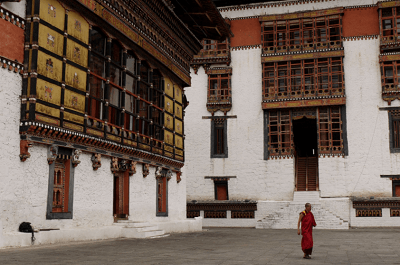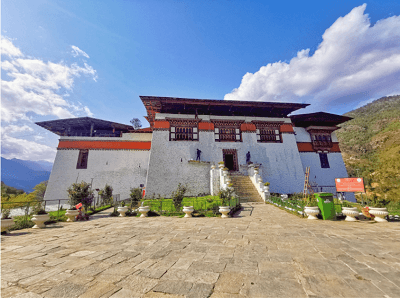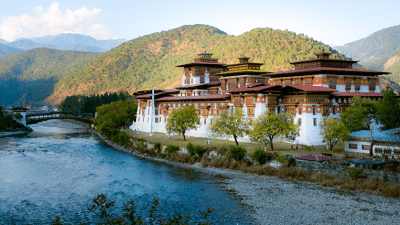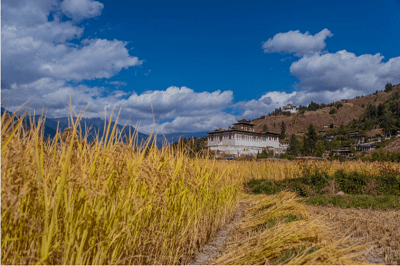Why are Dzongs important in Bhutan?
The country of Bhutan offers many fascinating experiences to visitors. The Buddhist kingdom has unique people, food, languages, culture, and traditions. During your stay in Bhutan, you will discover remarkable fortresses around the country – these are known as the dzongs.
The magnificent dzongs are a sight to behold. Its architecture is world-class and awe-inspiring. So much that other countries even have replicas of it.
Dzongs in Bhutan carry significant heritage and history.

But, what are these dzongs?
Dzongs are ancient Bhutanese fortresses constructed in the 17th century to defend against Tibetan invasions. They are made without iron nails and adorned with traditional Bhutanese woodwork and exquisite craftsmanship.
While traditionally, dzongs were used for defensive purposes and stocking grains in times of emergencies. These days, the dzongs are used for religious and administrative purposes. Dzongs have towering exterior walls with enclosed courtyards, temples, administrative offices, and monks' accommodation.
Each of the twenty districts in Bhutan will have at least one dzong. They are usually the venues for the popular tshechus or religious festivals.
Features of the dzongs
Dzongs were traditionally constructed using mud, stone and wood. The massive door entrances are made of wood and iron. The interior of the courtyard and temples are adorned with Buddhist art motifs and symbols.
A tower-like structure known as utse or central tower is located at the center of the courtyard, housing the main temples. It's the most important space within the dzong and is usually surrounded by a row of prayer-wheels. Pilgrims circumambulate the utse clock-wise and turn the prayer-wheels. The most sacred space within the central tower is the lhakhang, which means 'house of gods' or 'temple'. You can find statues of Buddha, Guru Rinpoche, bodhisattvas and other deities inside the lhakhang.
The construction of the dzongs are codified in Driglam Namzha. All the buildings must be constructed with multi-coloured wood frontages, small arched windows, and sloping roofs.
Dzongs in Bhutan vary in size, with some being much bigger than others. Find out the important and prominent dzongs in Bhutan.
Historical Importance
The dzongs are usually strategically located on top of hills or ridges overlooking the valleys. The dzongs are placed on higher grounds to defend the kingdom from British-India invasions from the south and Tibetan invasions from the north.
Administrative & Religious Significance
Aside from serving as military bases to protect the country from invaders, dzongs housed the administrative and monastic bodies. In addition, their open courtyard serves as a place for gathering and festival celebrations.
Today, it houses administrative and monastic bodies such as the secretariat, throne room, and government offices. Also, in the dzongs, you can find numerous valuable historical and religious artefacts.
Tourism & Cultural Value
Dzongs became an essential part of promoting the cultural development of the country. Due to its distinctive characteristics and rich heritage, visitors are often impressed with the majestic structures.
Important Dzongs in Bhutan
Simtokha Dzong
It is the first dzong built in the 17th century, still standing in its original form. It is officially known as Sangak Zabdhon Phodrang, which means 'Palace of the Profound Meaning of Secret Mantras'. In addition, this is the first dzong constructed by Zhabdrung Ngawang Namgyal, who is known as the unifier of Bhutan.
The beautiful historic fortress is located approximately 5 kilometres south of Thimphu on the old route from Paro to Phuentsholing. Zhabdrung Ngawang Namgyal constructed Simtokha Dzong in 1629. The Simtokha Dzong, strategically constructed on a projecting ridge with deep gullies, overlooks the whole Thimphu valley.
Today, you can find Bhutan's Institute for Language and Culture Studies above this dzong. It is presently found along the boundary between three western regions: Sha (Wangduephodrang), Wang (Thimphu) and Pa (Paro).
Learn more about Simtokha Dzong here.

Punakha Dzong
Constructed in 1637, Punakha Dzong was previously known as Pungtang Dechen Photrang Dzong or 'The Palace of Bliss or Great Happiness'. Its location was said to be chosen by Zhabdrung Ngawang Namgyel. Punakha Dzong holds the title of being the second oldest and second-largest dzong of the nation. It is associated with the Drukpa Lineage of Bhutan's Kagyu school of Buddhism.
It exemplifies Bhutan's world-class architecture and craftsmanship. With its magnificent structure, it has influenced architectural ideas from all over the globe, including the University of Texas at El Paso (UTEP), formerly known as Texas State School of Mines and Metallurgy. With its picturesque beauty, it is among the most visited dzongs in Bhutan.
Punakha Dzong is located at the intersection of the Mo Chhu (Female) and Pho Chhu (Male) rivers. To get to the dzong, you must cross the Bazam Bridge, reconstructed in 2008 after heavy floods destroyed the old bridge constructed in the 17th century.
Punakha Dzong is a six-storey structure with a central utse (tower) at the height of 1200 meters (3900 ft). All administrative activities take place in the northern yard. A vast white stupa and a Bodhi tree stand in the courtyard. The third courtyard is the most significant since it contains a significant temple as well as national treasures. Unfortunately, you are not permitted to enter; only the two appointed guards, the lama, the king, and the head abbot, are allowed to do so.
Learn more about Punakha Dzong here.

Tashichho Dzong
Tashichho Dzong, also known as Thimphu Dzong, is a fortress in Thimphu, Bhutan. It means "Fortress of the Glorious Religion" or "Fortress of Auspicious Doctrine." It houses the throne room and the offices of the King, the secretariat, and the ministries of home affairs and finance. It had served as the Royal Government of Bhutan's seat since 1952 when the capital was relocated from Punakha to Thimphu.
Lama Gyalwa Lhanangpa built it in 1216 A.D., where Dechen Phodrang currently sits above Thimphu. But, in 1641, Zhabdrung Ngawang Namgyal acquired it and found it small, so he constructed another building known as the 'Lower Dzong'. However, in 1771, the original dzong was destroyed by fire. Thus, moving everything in the lower dzong.
The dzong was extended many times throughout the years. In 1897, it was destroyed by the earthquake and reconstructed in 1902. After relocating the capital to Thimphu in 1952, King Jigme Dorji Wangchuck had it fully restored and expanded over five years traditionally, without the use of nails or written blueprints.
Learn more about Tashichho Dzong here.

Paro Dzong
It is among the prominent dzongs in Bhutan. Paro Dzong is the Paro district's administrative centre. The Paro Dzong, also officially known as the Rinpung Dzong, or "Fortress of the Heap of Jewels," was constructed in 1644 on the orders of Zhabdrung Ngawang Namgyal. It earned its name from its extensive collection of historic structures.
It is an ancient Bhutanese fortress with a complex of courtyards, temples, administrative buildings, and open space surrounded by towering walls. In addition, it is considered one of the finest examples of Bhutanese architecture, and it is among the top attractions in Bhutan.
The popular annual Paro Tshechu is held at the courtyard of Paro Dzong.
Learn more about Paro Dzong here.

Discover Breathtaking Bhutan
If you're a cultural or history buff, you'll definitely be fascinated and awed by the impressive fortresses of Bhutan.
Discover Bhutan through its cultural tour packages. You may consider taking a 7-day essential Bhutan tour, or spend 10-day to delve deeper into Bhutan. Check the best time to visit Bhutan and tips when you’re planning a trip to Bhutan.
Don’t forget to sign-up for our regular newsletter at drukasia.com/subscribe. If you have any enquiries, drop us an email at hello@drukasia.com.
